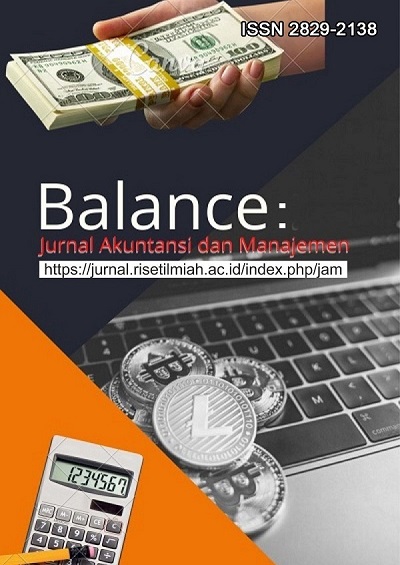Economic Factors Affecting Imports Per Capita in Indonesia: Empirical Evidence from the Error Correction Model
DOI:
https://doi.org/10.59086/jam.v4i1.611Keywords:
VECM, Poverty, Fiscal Policy, GDP, FDIAbstract
Downloads
References
Akermi, N., Ben Yedder, N., & Bakari, S. (2023). Impact of final consumption, domestic investment, exports, and imports on economic growth in Albania. https://mpra.ub.uni-muenchen.de/118308/
Asad, A. I., Pavelková, D., Pham, P. T., & Quddus, A. (2022). Impact of export and import on value addition of ready-made garments sector in Bangladesh. Journal of International Studies. https://www.ceeol.com/search/article-detail?id=1108008
Auboin, M., & Ruta, M. (2013). The relationship between exchange rates and international trade: a literature review. World Trade Review, 12(3), 577-605. https://doi.org/10.1017/S1474745613000025
Basuki, A. T., & Prawoto, N. (2019). Analisis Regresi: dalam Penelitian Ekonomi dan Bisni. Depok: Rajagrafindo Persada. https://repository.umy.ac.id/bitstream/handle/123456789/2051/C.2-NAno%20Prawoto.pdf?sequence=5
Ektiarnanti, R., Rahmawati, A., Fauziah, F. K., & Rofiqoh, I. I. (2023). Indonesian trade balance performance by GDP, exports, imports, BI rate and inflation as intervening variables. Indonesian Economic Review, 3(1), 1-11. https://doi.org/10.53787/iconev.v3i1.16
Greenland, A., Lopresti, J., & McHenry, P. (2019). Import competition and internal migration. Review of Economics and Statistics, 101(1), 44-59. https://direct.mit.edu/rest/article-abstract/101/1/44/58659/Import-Competition-and-Internal-Migration
Gujarati, D. N., & Porter, D. C. (2009). Basic econometrics. McGraw-hill.
Halpern, L., Koren, M., & Szeidl, A. (2015). Imported inputs and productivity. American economic review, 105(12), 3660-3703. https://www.aeaweb.org/articles?id=10.1257/aer.20150443
Hidayat, A. M., Purwanda, E., Hadijah, H. S., & Sodik, G. (2024). Impact of exchange rates, Inflation, foreign direct investment, government spending, and economic openness on exports, imports, and economic growth in Indonesia. Journal of Infrastructure, Policy and Development, 8(6), 3270-3270. https://doi.org/10.24294/jipd.v8i6.3270
Keskin, M., & Bağcı, S. A. (2024). The Impact of Taxation on International Commerce and Exchange Rate on Imports. Politik Ekonomik Kuram, 8(3), 798-813. https://doi.org/10.30586/pek.1504659
Khan, U., Khan, A. M., Alam, M. S., & AlKatheery, N. (2022). Causation between Consumption, Export, Import, and Economic Growth of Oman. Journal of Etikonomi, 21(1). https://doi.org/10.15408/etk.v21i1.20034
Khrustalev, E. Y., & Slavyanov, A. S. (2019). Dependence on imports as a threat to innovative development of the Russian manufacturing sector. Дайджест-финансы, 24(2 (250)), 124-134. https://doi.org/10.24891/df.24.2.124
Mankiw, N. G., & Taylor, M. P. (2020). Economics. Cengage Learning EMEA.
Mantalos, P. (2001). ECM-Cointegration test with GARCH (1, 1) Errors. Interstat, March. https://www.researchgate.net/profile/Panagiotis-Mantalos/publication/228529011_ECM-Cointegration_test_with_GARCH_1_1_Errors/links/555cba0408ae86c06b5d3ee6/ECM-Cointegration-test-with-GARCH-1-1-Errors.pdf
Ngene, A. N., Nwele, J. O., & Uduimoh, A. (2016). Evaluation of manufactured goods import and the manufacturing sector productivity in Nigeria. Saudi Journal of Business and Management Studies, 1(4), https://doi.org/186-95. 0.21276/sjbms.2016.1.4.5
Nguyen, N. H., NGUYEN, H. D., VO, L. T. K., & TRAN, C. Q. K. (2021). The impact of exchange rate on exports and imports: Empirical evidence from Vietnam. The Journal of Asian Finance, Economics and Business, 8(5), 61-68. https://doi.org/10.13106/jafeb.2021.vol8.no5.0061
Nopiana, E., Habibah, Z., & Putri, W. A. (2022). The Effect of Exchange Rates, Exports and Imports on Economic Growth in Indonesia. Marginal: Journal Of Management, Accounting, General Finance and International Economic Issues, 1(3), 111-122. https://ojs.transpublika.com/index.php/MARGINAL/
Oshungade, S. A. (2015). The relationship between gross domestic product (GDP), inflation, import and export from a statistical point of view (Doctoral dissertation, University of Sussex). https://sussex.figshare.com/articles/thesis/The_relationship_between_gross_domestic_product_GDP_inflation_import_and_export_from_a_statistical_point_of_view/23413421?file=41134292
Pangestu, M., Rahardja, S., & Ing, L. Y. (2015). Fifty years of trade policy in Indonesia: New world trade, old treatments. Bulletin of Indonesian Economic Studies, 51(2), 239-261. https://doi.org/10.1080/00074918.2015.1061915
Porkka, M., Guillaume, J. H., Siebert, S., Schaphoff, S., & Kummu, M. (2017). The use of food imports to overcome local limits to growth. Earth's Future, 5(4), 393-407. https://doi.org/10.1002/2016EF000477
Pudjiastuti, A. Q., Arisena, G. M. K., & Krisnandika, A. A. K. (2021). Rice import development in Indonesia. SOCA: Jurnal Sosial Ekonomi Pertanian, 15(2), 390-405. https://doi.org/https://doi.org/10.24843/SOCA.2021.v15.i02.p14
Rahim, M., Millia, H., Adam, P., & Saidi, L. O. (2020). Causality relation among export, import and exchange rate in Indonesia. International Journal of Scientific & Technology Research, 9(3), 3096-3102.
Resti, N., & Aimon, H. (2020, March). The Equilibrium Analysis of Domestic Consumption and Import (A Case Study in Indonesia). In 4th Padang International Conference on Education, Economics, Business and Accounting (PICEEBA-2 2019) (pp. 257-262). Atlantis Press. https://doi.org/10.2991/aebmr.k.200305.076
Sofjan, M. (2017). The effect of liberalization on export-import in Indonesia. International Journal of Economics and Financial Issues, 7(2), 672-676. https://dergipark.org.tr/en/pub/ijefi/issue/32035/354544
Sugiharti, L., Purwono, R., Primanthi, M. R., & Padilla, M. A. E. (2017). Indonesian productivity growth: Evidence from the manufacturing sector in Indonesia. Pertanika Journal of Social Science and Humanities, 25(S), 29-44. https://repository.unair.ac.id/123786/
Downloads
Published
How to Cite
Issue
Section
License
Copyright (c) 2025 Nano Prawoto

This work is licensed under a Creative Commons Attribution 4.0 International License.
This is an open-access journal. All works are published under the Creative Commons license CC-BY which means that all content is freely available at no charge to the user or his/her Institution. Users are allowed to read, download, copy, write, improve, and create derivative creation even for other lawful purposes, this license permits anyone to, as long as they cite and license the derivative creation under similar terms

This work is licensed under a Creative Commons Attribution 4.0 International License.
Similar Articles
- Nano Prawoto, Determinants of Poverty in Indonesia: A Dynamic Panel Analysis of Economic and Social Factors across 20 Provinces , Balance : Jurnal Akuntansi dan Manajemen: Vol. 3 No. 3 (2024): Desember 2024
You may also start an advanced similarity search for this article.
Most read articles by the same author(s)
- Nano Prawoto, Determinants of Poverty in Indonesia: A Dynamic Panel Analysis of Economic and Social Factors across 20 Provinces , Balance : Jurnal Akuntansi dan Manajemen: Vol. 3 No. 3 (2024): Desember 2024


















